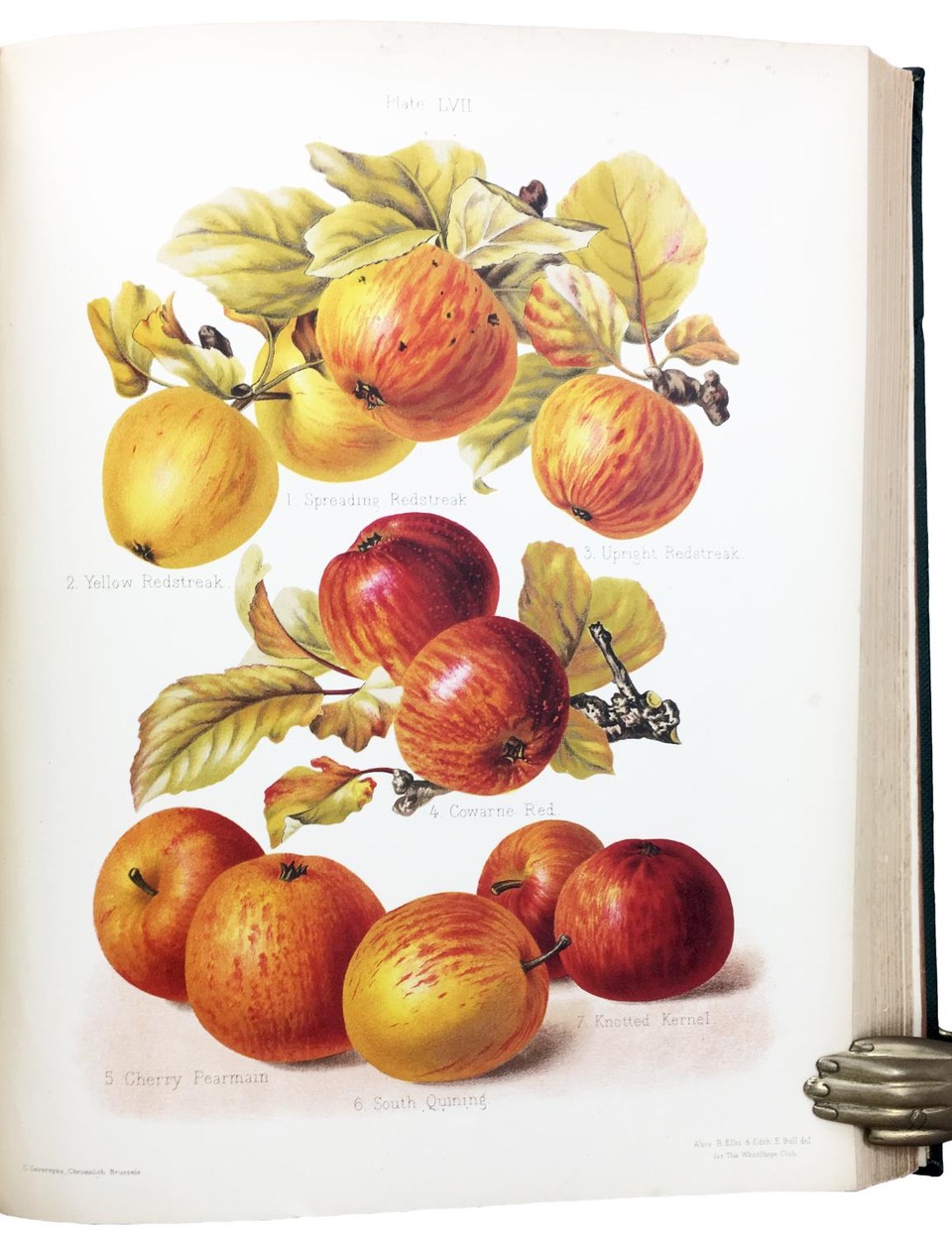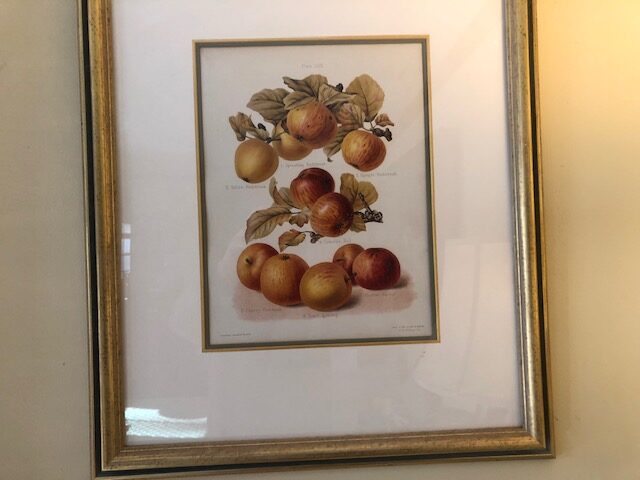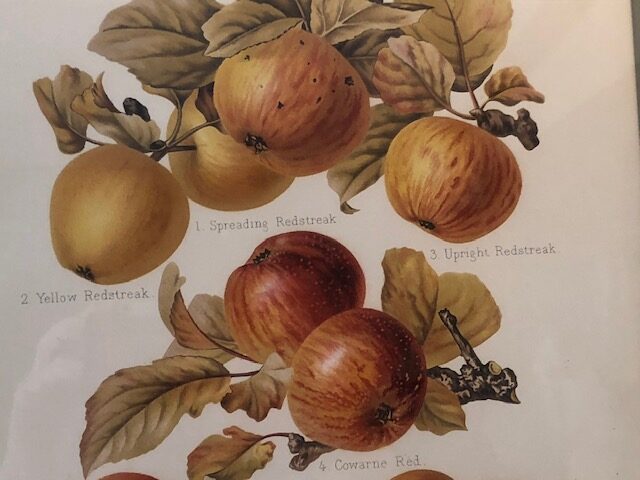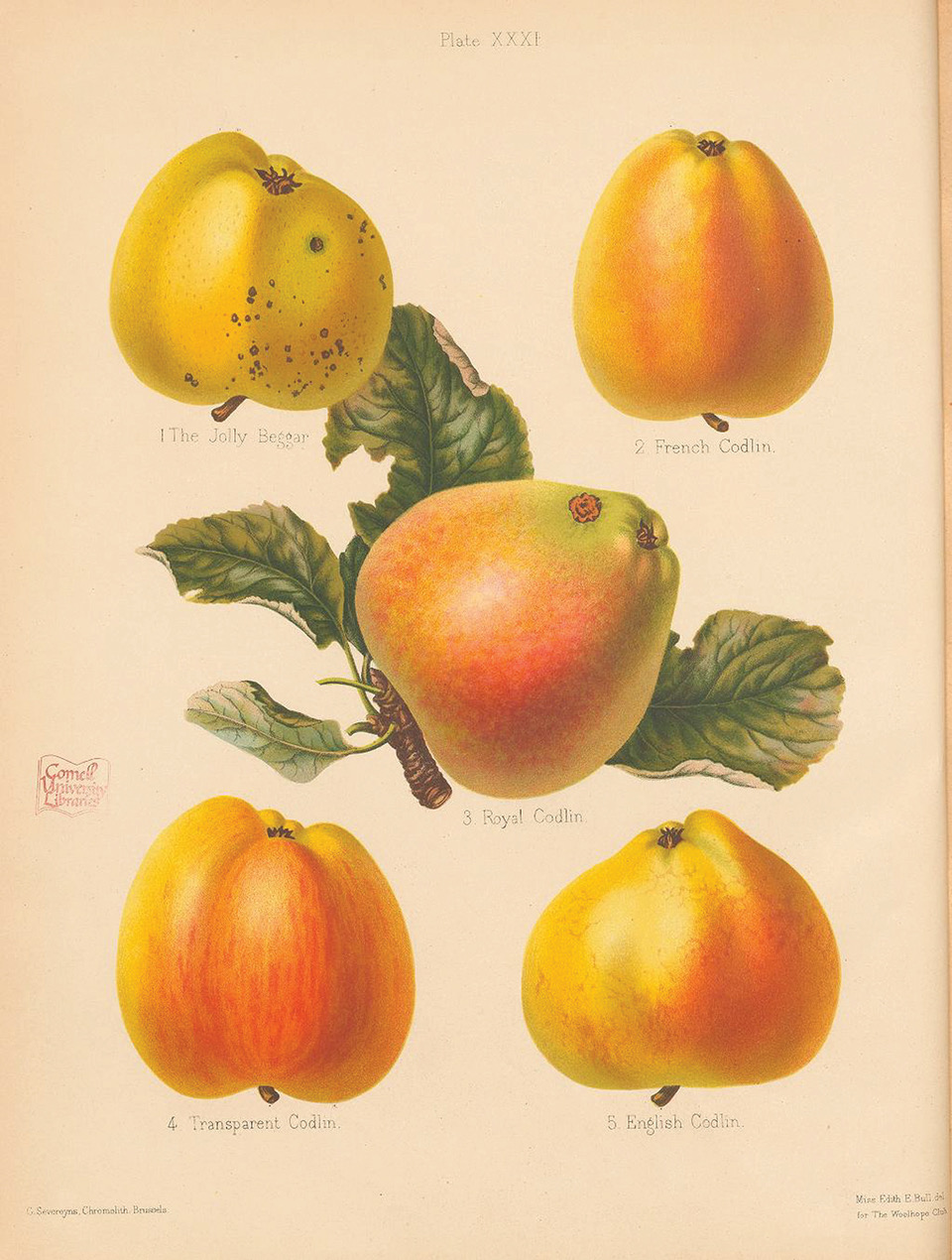EPISODE 522 HARD CIDER AT A SCHOOL DANCE LEADS TO HEREFORDSHIRE POMONA







alan skeoch
january 28, 2022

The Redstreak apple … one of the most famous apples in the world
HEY, KID! DO YOU WANT A SLUG OF HARD CIDER?
Date October, 1953
Place Humberside Collegiate auditorium
Purpose: School Dance
Startling Event: Crock of hard cider passed around
Person: Alan Skeoch, Grade 9
“Here take a slug of this, kid…right from the gallon crock.”
“What is it?”
“Never you mind…take a slug or pass it on. Consider
the stuff an initiation into high school.”
“But what is it?”
“Grow up kid, it’s just hard cider…Ontario hard cider….won’t kill you.”
“Not too sure.”
“Your a big man now, kid…no short pants anymore…take a slug.”
That happened a long time ago. Back in 1953 at Humberside Collegiate’s first fall dance. My eyes were wide
open…saucers taking in a new world of big kids. I think I took a slug but not too sure. I know I whirled Elizabeth
Kilty a little too fast on the dance floor and her skirt went up like Marilyn Monroe’s. That could have been the hard
cider at work.
Hard cider! Quite common and not wonderfull…looked sort of muddy and tasted way too sweet to be enjoyed.
Years later I discovered why this elicit booze was not so great. Our cider, Ontario cider in unlabelled gallon crocks
was made with windfall applies likely. Apples from a bunch of trees. Maybe even wormy! Who could tell if worms
were present once the apples were ground to pulp with a spiked roller and then pressed in a wooden press
that had been sitting in a barn or back yard garage for a year.
I never developed a taste for hard cider after that welcome by the big boys at Humberside.
Never is the wrong word. In 1965 , Marjorie, Eric and I lived on hard cider for one wonderful summer.
Bulmer’s hard cider and the occasional mug of “Scrumpy” from beneath a pub plank counter. The
scrumpy reminded me of the gallon crock stuff. But the commercial Bulmer’s cider was wonderful
and inexpensive. Our tour of England, Ireland and Scotland in 1965 floated on English cider…Herefordshire
English cider in heavy glass quart bottles with stoneware screw tops. Available everywhere along with
all kinds of cheeses and great turtle shaped loaves of fresh bread. The cost was minimal and the place
to dine could be a dry stone fence or a great pile of loose stacked hay in a farm field.
That kind of cider is sold in LCBO stores even today. About $3 a can. No stone topped bottles anymore.
WHY IS HEREFORDSHIRE CIDER SO ADMIRED BY THOSE WHO THIRST”
“The Redstreak cider apple is one of the oldest cider apples in circulation. A few books establish the Redstreak cider apple trees to Herefordshire in 1600’s. One book notes the Redstreak cider apples were considered ‘fit for Princess’ establishing Herefordshire’s reputation as the cider country of England. Produces a good quality bittersweet juice, an excellent addition for blending. The fruit is medium to small yellow apple with red strip”
(ADVERTISEMENT by one Hereford nursery now offering Cider Apple trees at $44.90 each)
What is so special about English cider…especially Herefordshire English cider? It’s the apples.
Special cider applies…the greatest of which was the REDSTREAK. Not a spectacular apple. Very
nondescript…small, perhaps a bit of apple scab…yellow background with red streaks…bitter sweet
taste. Definitely not an eating apple or an applesauce apple. But a perfect cider apple. Proved so
by centuries of care. Imported into Hereford and named the “Scudamore Crab“, having first been intensively planted by the diplomat and politician John Scudamore, 1st Viscount Scudamore from France and grown
on his country estate. Noted as being present as far back as 1600.
DO NOT BUY APPLE REDSTREAK APPLE SEEDS…APPLES DO NOT BREED TRUE.
Apples do not breed true. Orchards with mixed varieties will never produce Redstreak apples.
They must be grafted from cuttings. Edward Freeman, my grandfatheer, was good at grafting. Our farm once had
wild apple trees on which he grafted prize apples but granddad never produced fine cider.
His alcohol thirst was satisfied with rhubarb wine and the occasional bottle of whisky that mom
smuggled into the fifth line kitchen unseen by the ‘lips that touch liquor will never touch mine’ crowd.
Granddad did love apples and he knew how to get apples with his grafting knife and wax.
I remember some branches on Edward Freeman’s wild apple trees we’re loaded with fruit while
the rest of the tree had tiny apples or none at all. I was too young to know that Edward Freeman had
been busy grafting.

Herefordshire Redstreak apple today…small, bitter, bit of scab…and lots of thick skin..perfect for cider.
This is only the beginning of my apple episode. A teaser. The bigger story is coming. Previous episodes have
outlined the nature of the Country Estates…up to 5,000 o them…that were being built and renovated by
affluent English families during the 18th and 19th centuries. Along with the renovations came the desire
to develop unique gardens with plants gathered by plant collectors roaming the seven seas. Some plants
did not need to be distant. There were so many apple varieties in England that many had no names. Thousands
of apple varieties most of them unidentified.
Not for long. Head Gardeners and owners of these country estates began paying attention to the wealth of apple varieties, particularly those
in Herefordshire. Walled gardens had sections for fruit orchards…exotic fruit like peaches and nectarines but
also apples and pears. My grandfather, Edward Freeman, was one of these head gardeners for a short few years between 1898 and 1906
at Eywood Court in Herefordshire. Some of His plantings still existed in the 1960’s, perhaps still do.
From 1878 to 1884 or thereabouts two women were at work with paint brushes making Hereford Apples
famous among art lovers and gardeners.
The most spectacular art of the apple emerged at the same time as the gardeners nursed their orchards from decline
to explosive growth.
What emerged was one of the wonders of the world of the
apple. Two volumes of wonderful art were produced by two ladies between 1878
and 1884 titled THE HEREFORDSHIRE POMONA. Only 600 copies were printed. Volumes
that are so highly valued today that when copies were moved from one place to another
they were accompanied by armed guards. (*that will be subject of Episode 523 coming next)
Book breakers have broken the spines of many of these books and then professional
framers have enclosed the apple artwork into high cost lithographic art.
Shortly after 1965 Marjorie and I were able to buy two of these pages. They now
hang in our house. Visitors hardly notice them. Who would want a picture of
a bunch of apples in their living room? One of these (right in picture below) is
the famed Redstreak now lost to the world.

Our living room is small but features two very famous lithographs on the north wall…see them?

One is more famous than the other…our dog Woody is aligned perfectly…his body
points to the picture. See it?

Close up…just a picture of some apples, right? Wrong…picture of the Redstreak
apple variety. Now believed to be extinct.

THE famed redstreak cider apple…the cornerstone of great hard cider. Nondescript
in appearance. Small. yellowish skin covered with red streaks. Not tasty. But when converted from apple juice to hard apple
cider a wonder happens.
| ‘Redstreak’ | |
|---|---|
 |
|
| Species | Malus domestica |
| Breeder | John Scudamore, 1st Viscount Scudamore |
| Origin | |
“The Redstreak, also spelt Redstrake, Red Streak or Red-streak, is or was a very old variety of cider apple formerly commonly planted in England.
It is sometimes referred to as the Herefordshire Redstreak or Old Redstreak to distinguish it from later-developed varieties, such as the Somerset Redstreak, with a similar name.
Excerpt from Wikipedia below
The variety is traditionally said to have first appeared in the early 17th century; John Evelyn recorded that it was originally named the “Scudamore Crab“, having first been intensively planted by the diplomat and politician John Scudamore, 1st Viscount Scudamore.[1] Scudamore’s efforts in improving and raising fruit trees on his estate at Holme Lacy were an attempt to match the superior French cider available at the time.[2] Scudamore had been ambassador to France, and supposedly raised this apple from a pip brought back from there.
During the 17th century, the Redstreak (as the apple was later to become known) became celebrated as the finest cider apple variety in England, and was the source of Herefordshire‘s reputation as the premier cider-producing region in the country.[3] Scudamore himself assisted in popularising the drink, having tall, elegant glasses for it engraved with his and the royal arms, and setting up large-scale production at Holme Lacy, where the cider was bottled and kept in water-cooled cellars.[4]
For a time cider made from Redstreak apples changed hands at extraordinarily high prices – as high as the best imported wine – but by the late 18th century the variety was already in decline.[3] By the 19th century the Redstreak was reported to be almost extinct, much like the Styre, another formerly well-known cider apple variety that had suffered from an apparent decline in quality and productiveness. Thomas Knight‘s Pomona Herefordiensis (1811), noted that “trees of the Red-streak can now no longer be propagated; and the fruit, like the trees, is affected by the debilitated old age of the variety, and has in a very considerable degree, survived those qualities to which it was owing its former fame”.
This decline may have occurred in older apple cultivars as viruses gradually built up in their tissues over time and were transferred during propagation, with increasing negative effects on productiveness, vigour and even flavour.[5]
Herefordshire Redstreak” apples are currently available from some nurseries, but it is unclear whether these are related to the original variety, which may now be extinct.”
CONCLUSION…BUT NOT THE END OF THE STORY
Over my lifetime I have found and tasted many wild apples whose parent tree was
planted by birds and animals. Each wild tree is approached with hope and wonder but
none have approached the Redstreak. But how would I know? Honestly I will
never know because few have ever been crushed and squeezed . I may have
missed the great Canadian cider apple.
Next Episode “ THE STORY OF THE HEREFORDSHIRE POMONA
(Includes the Redstreak Cider Apple…when I tell this story I get
emotional…such a wonderful story.)
post script: Some cider apples trees available today in Herefordshire nursary
-
Cider apple tree
Brown Snout
A traditional English bittersweet cider apple.- Pollination group: 6
- Uses: Hard cider
- Self-fertility: Not self-fertile
-
Cider apple tree
Brown’s Apple
Brown’s Apple is a traditional English cider apple variety producing a sharp juice.- Pollination group: 5
- Uses: Hard cider
- Self-fertility: Not self-fertile
-
Cider apple tree
Bulmers Norman
A traditional English bittersweet cider apple.- Pollination group: 3
- Uses: Hard cider
- Self-fertility: Not self-fertile
-
Cider apple tree
Chisel Jersey
Chisel Jersey is a traditional English hard cider apple variety, producing a bittersweet juice.- Pollination group: 6
- Uses: Hard cider
- Self-fertility: Not self-fertile
-
Cider apple tree
Dabinett
Dabinett is a traditional English cider apple variety, producing a bittersweet juice.- Pollination group: 6
- Uses: Hard cider
- Self-fertility: Self-fertile
-
Cider apple tree
Ellis Bitter
Ellis Bitter is a traditional and popular English cider apple, producing a bittersweet juice.- Pollination group: 5
- Uses: Hard cider
- Self-fertility: Not self-fertile
-
Cider apple tree
Geneva Tremlett’s Bitter
A bittersharp cider apple variety, found at the USDA repository at Geneva, but probably of English origin.- Pollination group: 4
- Uses: Hard cider
- Self-fertility: Not self-fertile
-
Cider apple tree
Harry Masters Jersey
Harry Masters Jersey is a traditional English cider apple variety, producing a bittersweet juice.- Pollination group: 4
- Uses: Hard cider
- Self-fertility: Not self-fertile
-
Cider apple tree
Kingston Black
Kingston Black is one of the premier English cider varieties and produces a bittersharp juice.- Pollination group: 4
- Uses: Hard cider
- Self-fertility: Not self-fertile
-
Cider apple tree
Major
A traditional English bittersweet hard-cider variety.- Pollination group: 3
- Uses: Hard cider
- Self-fertility: Not self-fertile
-
Cider apple tree
Porter’s Perfection
Porter’s Perfection is a 19th century English cider variety producing a bittersharp juice.- Pollination group: 3
- Uses: Hard cider
- Self-fertility: Not self-fertile
-
Cider apple tree
Somerset Redstreak
An English cider apple variety producing a very high-quality bittersweet juice.- Pollination group: 5
- Uses: Hard cider
- Self-fertility: Not self-fertile
-
Cider apple tree
Stembridge Cluster
A traditional English bittersweet cider apple from the town of Stembridge in Somerset.- Pollination group: 2
- Uses: Hard cider
- Self-fertility: Not self-fertile
-
Cider apple tree
Stoke Red
A traditional English cider apple producing a bittersharp juice.- Pollination group: 6
- Uses: Hard cider
- Self-fertility: Not self-fertile
-
Cider apple tree
Sweet Coppin
A traditional English cider variety, producing a sweet juice.- Pollination group: 3
- Uses: Hard cider
- Self-fertility: Not self-fertile
Excerpt from the Hereford Pomona below…work done by two ladies who should never be forgotten.
see next Episode for full story. There is quite a difference between an apple photograph (page above) and the
apples painted in the Herefordshire Pomona, (page below)

















